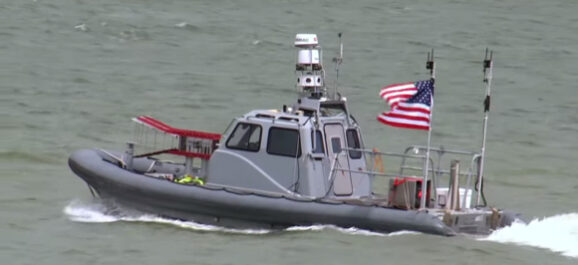U.S. Navy Has Swarming Autonomous Drone Boats
 Robots that assemble and swarm have been around for a while, but never like this. In addition to lasers that shoot down drones and robotic firefighters, the U.S. Navy now has automated boats that can launch a coordinated defense or attack on any threatening vessel in the water.
Robots that assemble and swarm have been around for a while, but never like this. In addition to lasers that shoot down drones and robotic firefighters, the U.S. Navy now has automated boats that can launch a coordinated defense or attack on any threatening vessel in the water.
The advanced ship protection system is designed to prevent attacks such as the one on the U.S.S. Cole in 2000. Navy ships would be accompanied by fleets equipped by Control Architecture for Robotic Agent Command and Sensing (CARACaS, a system that includes sensors and software that alert those boats to the presence of a threat on the water. When a suspicious vessel is identified, five ships in the fleet swarm to investigate.
Part of the idea is that whoever is in the oncoming vessel will be scared and intimidated, and not want to mess with a bunch of boats. Ideally, the tactic would prevent a confrontation, much the way guard dogs might. But these boats can also take offensive action, provided they’re armed. They don’t get to decide for themselves whether to fire at another vessel, though—a human naval officer on a nearby ship would have to do that. But the boats can make some of their own decisions, such as the quickest route based on radar data or the best formation in which to approach a potentially hostile vessel.
The system can be transferred to any ship, which means the Navy doesn’t have to build or buy any specific craft to use it. It costs only $2,000 to outfit a boat with the system, so it’s surprisingly cost-effective. CARACaS was originally developed for NASA’s Mars rovers, which use sensors to navigate the rugged terrain. And while the swarm aspect isn’t a part of the original system, it’s fun to imagination Curiosity and Opportunity tag-teaming a weird-looking rock.
In addition to preventing attacks like the one on the Cole and keeping sailors out of harm’s way, the swarms of boats can also help protect U.S. ports. The U.S. Coast Guard joined the Navy during the recent tests of the system, which demonstrated the ability of up to 13 autonomous or remotely controlled boats that escorted an important Navy ship, and then swarmed around a simulated enemy ship. According to the Office of Naval Research, the system will be tested in the field in the next year. Of course, if the Navy really wants to scare its enemies, it would man those boats with robot pirates.











